Abstract
Early histological changes in the thyroid gland were examined in 30 patients with juvenile thyrotoxicosis, by means of needle biopsy. Based on the degree of lymphocytic infiltration and degenerative changes in follicular epithelium, results were classified into four groups. A: hyperplastic changes without cellular infiltration (6 patients, 20%); B: hyperplastic changes with areas of focal thyroiditis less than 30% of specimen (10 patients, 33%); C: those with 30 to 60% areas ot thyroiditis (10 patients, 33%); D: almost diffuse thyroiditis (4 patients, 13%). Moderate to severe lymphocytic thyroiditis was frequently present in the early stage of hyperplastic thyroid glands. The clinical significance of the 4 histological groups was evaluated. Neither clinical signs nor routine laboratory tests could differentiate these groups except group D, in which thyrotoxic signs were mild and transient. However, serum antithyroid antibodies tended to increase in accordance with severity of thyroiditis. The rate of remission was high in groups C and D, whereas relapse was frequent in group A. These results suggest that Grave's disease and chronic lymphocytic thyroiditis are closely related in the early stage of thyrotoxicosis in children, and that the clinical course may be considerably altered by the degree of associated thyroiditis.
Full text
PDF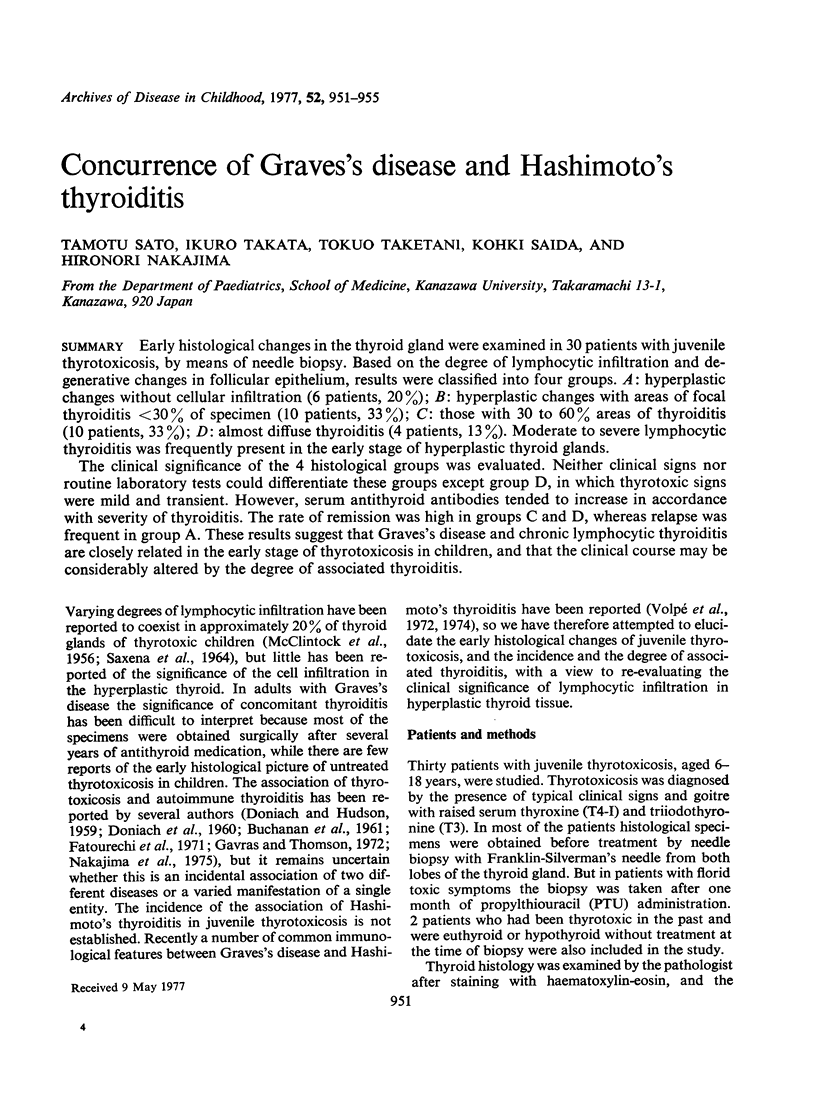
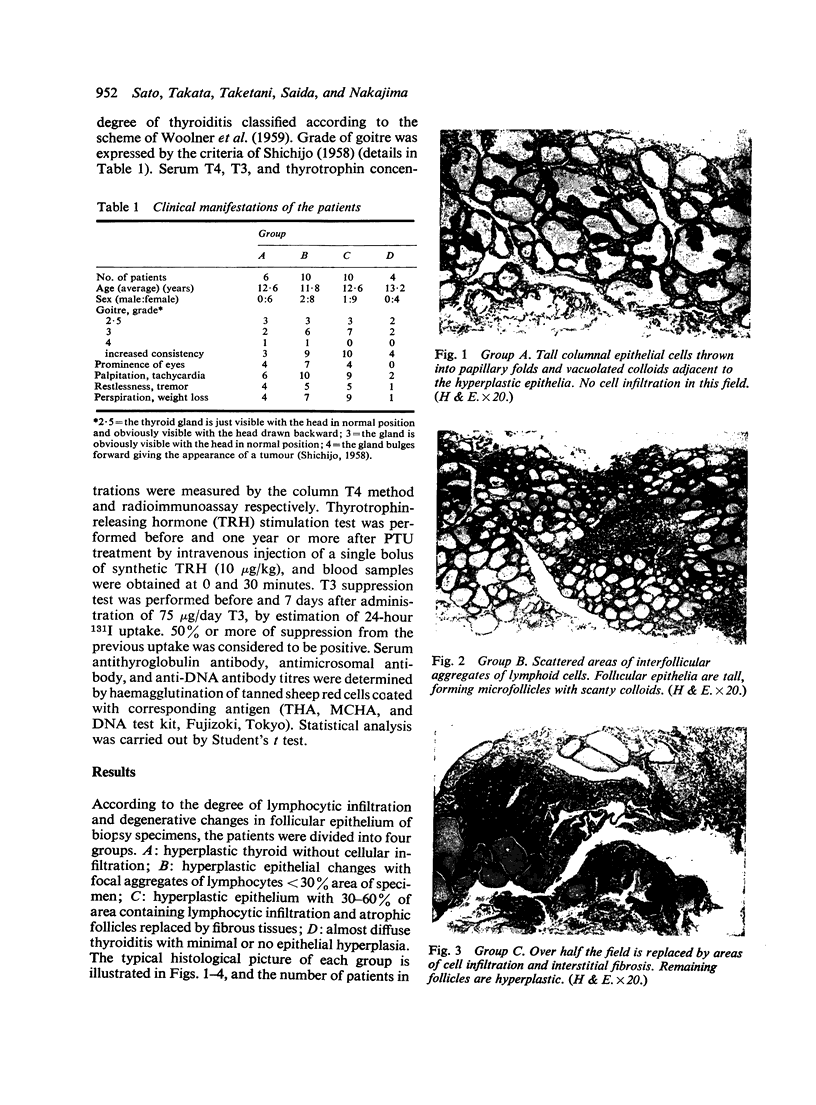
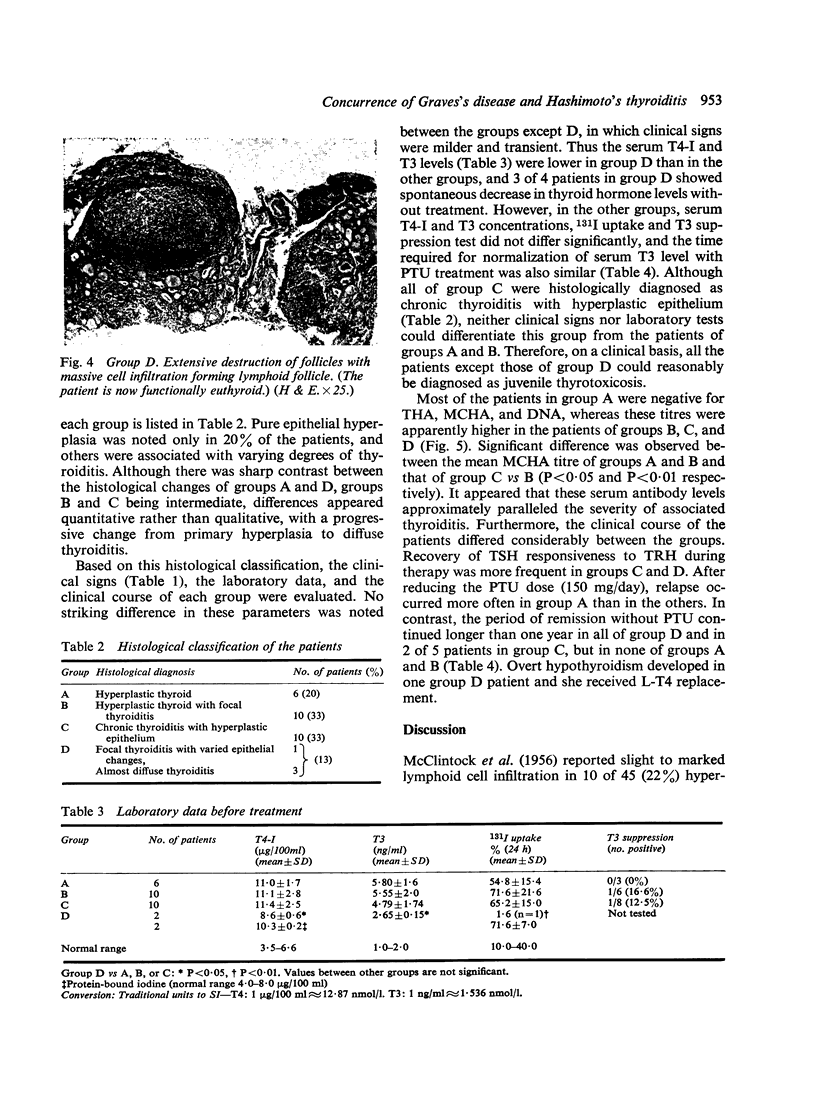
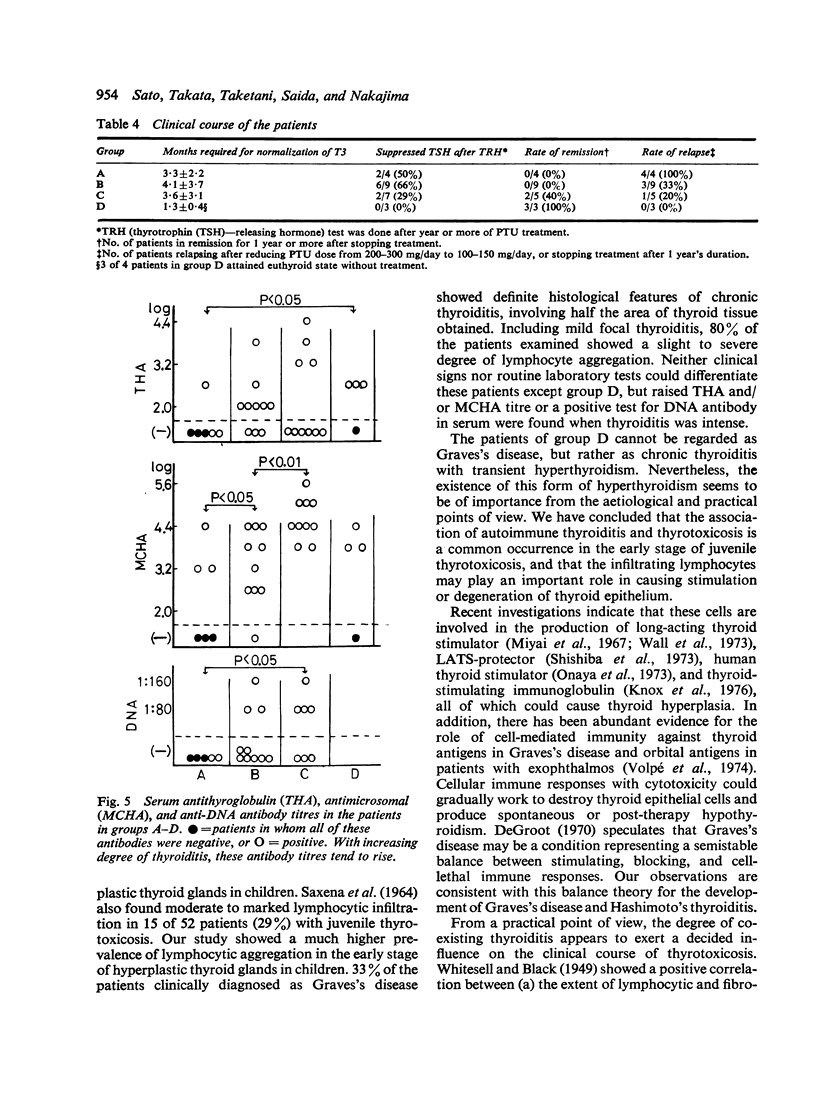
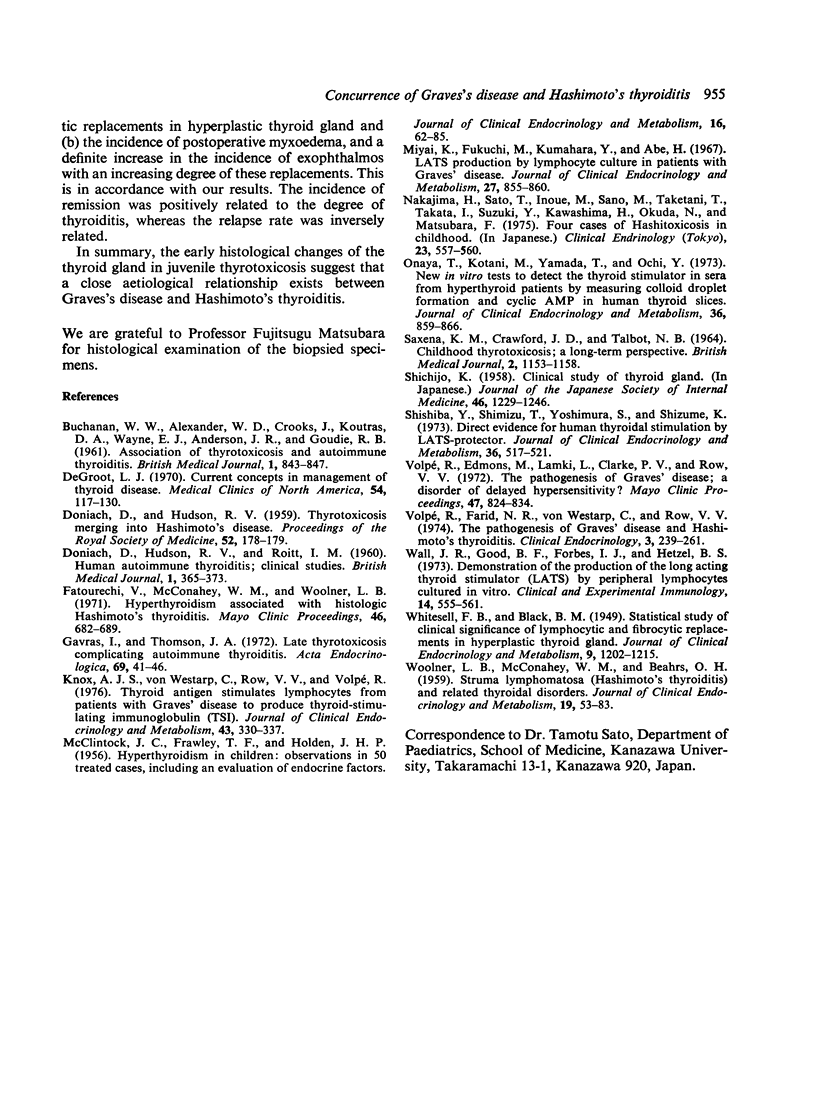
Images in this article
Selected References
These references are in PubMed. This may not be the complete list of references from this article.
- Buchanan W. W., Alexander W. D., Crooks J., Koutras D. A., Wayne E. J., Anderson J. R., Goudie R. B. Association of Thyrotoxicosis and Auto-immune Thyroiditis. Br Med J. 1961 Mar 25;1(5229):843–847. doi: 10.1136/bmj.1.5229.843. [DOI] [PMC free article] [PubMed] [Google Scholar]
- DONIACH D., HUDSON R. V., ROITT I. M. Human auto-immune thyroiditis: clinical studies. Br Med J. 1960 Feb 6;1(5170):365–373. doi: 10.1136/bmj.1.5170.365. [DOI] [PMC free article] [PubMed] [Google Scholar]
- DeGroot L. J. Current concepts in management of thyroid disease. Med Clin North Am. 1970 Jan;54(1):117–130. [PubMed] [Google Scholar]
- Fatourechi V., McConahey W. M., Woolner L. B. Hyperthyroidism associated with histologic Hashimoto's thyroiditis. Mayo Clin Proc. 1971 Oct;46(10):682–689. [PubMed] [Google Scholar]
- Gavras I., Thomson J. A. Late thyrotoxicosis complicating autoimmune thyroiditis. Acta Endocrinol (Copenh) 1972 Jan;69(1):41–46. doi: 10.1530/acta.0.0690041. [DOI] [PubMed] [Google Scholar]
- HUDSON R. V. Thyrotoxicosis merging into Hashimoto's disease. Proc R Soc Med. 1959 Mar;52(3):178–179. [PMC free article] [PubMed] [Google Scholar]
- Knox A. J., von Westarp C., Row V. V., Volpé R. Thyroid antigen stimulates lymphocytes from patients with Graves' disease to produce thyroid-stimulating immunoglobulin (TSI). J Clin Endocrinol Metab. 1976 Aug;43(2):330–337. doi: 10.1210/jcem-43-2-330. [DOI] [PubMed] [Google Scholar]
- MCCLINTOCK J. C., FRAWLEY T. F., HOLDEN J. H. Hyperthyroidism in children: observations in 50 treated cases, including an evaluation of endocrine factors. J Clin Endocrinol Metab. 1956 Jan;16(1):62–85. doi: 10.1210/jcem-16-1-62. [DOI] [PubMed] [Google Scholar]
- Miyai K., Fukuchi M., Kumahara Y., Abe H. LATS production by lymphocyte culture in patients with Graves' disease. J Clin Endocrinol Metab. 1967 Jun;27(6):855–860. doi: 10.1210/jcem-27-6-855. [DOI] [PubMed] [Google Scholar]
- Onaya T., Kotani M., Yamada T., Ochi Y. New in vitro tests to detect the thyroid stimulator in sera from hyperthyroid patients by measuring colloid droplet formation and cyclic AMP in human thyroid slices. J Clin Endocrinol Metab. 1973 May;36(5):859–866. doi: 10.1210/jcem-36-5-859. [DOI] [PubMed] [Google Scholar]
- SAXENA K. M., CRAWFORD J. D., TALBOT N. B. CHILDHOOD THYROTOXICOSIS: A LONG-TERM PERSPECTIVE. Br Med J. 1964 Nov 7;2(5418):1153–1158. doi: 10.1136/bmj.2.5418.1153. [DOI] [PMC free article] [PubMed] [Google Scholar]
- Shishiba Y., Shimizu T., Yoshimura S., Shizume K. Direct evidence for human thyroidal stimulation by LATS-protector. J Clin Endocrinol Metab. 1973 Mar;36(3):517–521. doi: 10.1210/jcem-36-3-517. [DOI] [PubMed] [Google Scholar]
- Volpe R., Edmonds M., Lamki L., Clarke P. V., Row V. V. The pathogenesis of Graves' disease. A disorder of delayed hypersensitivity? Mayo Clin Proc. 1972 Nov;47(11):824–834. [PubMed] [Google Scholar]
- Volpé R., Farid N. R., Von Westarp C., Row V. V. The pathogenesis of Graves' disease and Hashimoto's thyroiditis. Clin Endocrinol (Oxf) 1974 Jul;3(3):239–261. doi: 10.1111/j.1365-2265.1974.tb01800.x. [DOI] [PubMed] [Google Scholar]
- WHITESELL F. B., Jr, BLACK B. M. A statistical study of the clinical significance of lymphocytic and fibrocytic replacements in the hyperplastic thyroid gland. J Clin Endocrinol Metab. 1949 Nov;9(11):1202-15, illust. doi: 10.1210/jcem-9-11-1202. [DOI] [PubMed] [Google Scholar]
- WOOLNER L. B., McCONAHEY W. M., BEAHRS O. H. Struma lymphomatosa (Hashimoto's thyroiditis) and related thyroidal disorders. J Clin Endocrinol Metab. 1959 Jan;19(1):53–83. doi: 10.1210/jcem-19-1-53. [DOI] [PubMed] [Google Scholar]
- Wall J. R., Good B. F., Forbes I. J., Hetzel B. S. Demonstration of the production of the long acting thyroid stimulator (LATS) by peripheral lymphocytes cultured in vitro. Clin Exp Immunol. 1973 Aug;14(4):555–561. [PMC free article] [PubMed] [Google Scholar]






